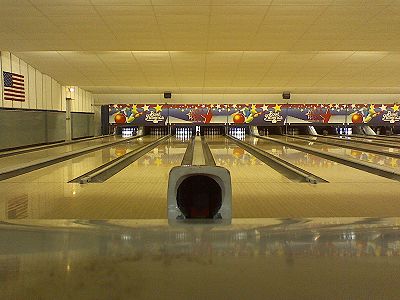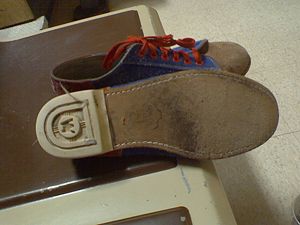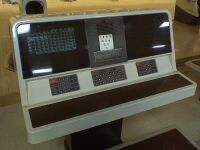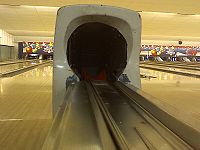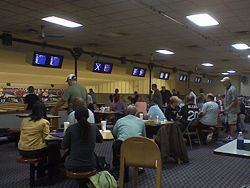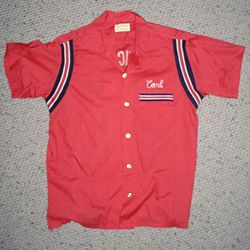Pin bowling
Bowling is an indoor sport in which a player rolls a large, heavy ball down a polished wooden lane to hit a cluster of pins in order to achieve the maximum amount of pin-falls. Although an individual person can play a game, most bowlers compete against other players as each of them tries to attain the highest number of pin-falls for that particular game.
Most bowling alleys today have not changed much since their initial construction many years ago, except for mechanical and computer system upgrades. Unless the alley has undergone serious renovation it is not unusual to see the original tables, chairs, fixtures, walls, and ceiling tiles. There are, however, a few very modern, "upscale" bowling alley establishments such as Lucky Strike Lanes where "proper" attire and behaviors are expected.
Terminology
- Alley: the establishment where bowling takes place; also called the "bowling alley".
- Approach: the method in which a bowler travels from a starting position to the throw line manipulating his or her body in conjunction with the bowling bowl to achieve the greatest possible attempt.
- Bowling ball: a ball typically made of urethane/polyurethane or some other composite plastic, with a specific weight and three holes drilled which are reserved usually for the thumb, middle, and ring fingers.
- Frame: a single round, consisting of two attempts to knock all pins down, with an exception on frame 10.
- Gutter: two channels that lie on either side of the lane that conform to the shape of the bowling ball. Rolling a ball into a gutter results in a score of zero for that attempt and is known as a "gutter ball."
- Lane: the entire distance between the pins and the throw line.
- Pin: a white wooden construct that when knocked down counts as one point.
- Spare: knocking down all 10 pins down in a single frame within two attempts. Designated on a scorecard by the symbol "/"
- Strike: knocking down all 10 pins down in a single frame with one attempt. Designated on a scorecard by the symbol "X"
- Turkey: scoring three or more strikes in a row.
- 10th frame: the last frame in a single game. The maximum amount of attempts that may occur in frame 10 is three, providing each attempt results in a strike, or if a spare occurs in the first two attempts during this frame, or if a strike is the first ball thrown.
Equipment
Although the primary piece of equipment used by the player is the bowling ball, it is a requirement that players wear special shoes, "bowling shoes", when playing. These shoes are different from regular shoes in that the heel and sole of the shoe are made of specific materials, not only for protection of the lanes (reduce scuffmarks, damage to the wood), but also for the protection of the player as well. The shoes are designed to have a small amount of "slide", because the momentum from releasing the bowling ball transfers to the foot. A shoe with a pure rubber sole provides greater traction and little or no "give" on the lane surface; as a result the increased friction in the material could result in a potential injury.
Some professional bowlers prefer to use a special "bowling glove" or a wrist brace that holds the wrist and base of the hand into a specific position that reduces stress incurred from forcing the musculature to remain still during the approach and release. This position is not too dissimilar from that of a handshake.
Additionally, some may also prefer towels and a special talc that keeps the bowling ball drill holes free from moisture and lane grease, and reduces the friction of the release, allowing the fingers to slide out of the holes more easily at the release.
Practically all alleys have their own equipment for public use: a relatively large variety of bowling balls and shoes that may be rented for a small cost, but many alleys also have their own "pro shops" that sell these items as well. Consequently, many of the items having been used by many people are subject to accelerated wear and tear even though they are maintained. It is not uncommon to find bowling shoes' shoelaces knotted up and frayed at the ends, and not stiff in any way (in fact they may feel more like slippers). Usually it will take some searching and prodding to find an alley-owned bowling ball that is the right hand and finger size and also of appropriate weight.
When buying equipment (shoes, ball, accessories), one should take into consideration shoe size, ball weight, and whether or not to purchase either a ball bag or a sling. A ball bag has the advantage of having room for both bowling shoes and a ball vis a metal or plastic undercarriage at the bottom of the bag, as well as pockets for non-slip, talc, and a towel whereas a sling is just a piece of cloth shaped and stitched with two handles to carry the ball. Additionally, most pro-shops will be able to recommend a ball weight, measure finger hole sizes, drill, finish, and etch one's name into the bowling ball. It is important to be aware that most pro-shops have "normal" working business hours (9pm to 5pm) and some close even earlier.
For avid bowlers, storage lockers may also be available for a monthly or yearly rental fee.
Objective
The objective of the game is to maximize the possible amount of pins one may score throughout the frames.
Rules
Bowling, of all the physical sports, may possibly have the fewest rules concerning how the game is played. Any method may be used to get the bowling ball from the throw line to the pins, which offers a great amount of flexibility. However, a bowler may not cross the throw line; doing so results in a fault or "error" and forfeits any points made in that frame. Additionally, if a ball knocks down any pins after recoiling out of the gutter, those points will be invalidated and the frame may be lost.
Scoring
There is a system for scoring pins in bowling. Any number of pins knocked down in a single frame count for their face value, except if all pins are knocked down in the first attempt. This is registered as a strike. If the remaining pins are knocked down in the second attempt, it is registered as a spare.
Scoring a strike or a spare incurs an additional bonus on the next frame. A strike will accrue additional points in the frame it was scored in based on the next two successive throws. A spare will accrue additional points in the frame based on the very next successive throw. These bonuses do stack with successive frames.
Scoring a spare
| Template:Bowlingscoresheet | Template:Bowlingscoresheet | Template:Bowlingscoresheet | Template:Bowlingscoresheet |
In Frame three, John scores a spare. In the very next roll in frame four, he only rolls a one. Normally, 7+2+6+1+9+1 = 26. However, the next roll following the spare (first roll, frame four) is accounted into that frame (frame three). The total for frame three is 7+2+6+1+9+1+1 = 27.
Scoring a strike
| Template:Bowlingscoresheet | Template:Bowlingscoresheet | Template:Bowlingscoresheet | Template:Bowlingscoresheet |
In this example, Susan rolls a strike in frame two. Since a strike counts the next two successive throws, the two rolls from frame three are accounted for in frame two, 3+0+10+2+2=17.
Scoring a spare in every frame gives a total score of 150. Scoring a strike in every frame yields a total possible score of 300, otherwise known as a "perfect game".
In this example, scoring a mark in frame ten allows one additional roll.
Mechanics
Most scoring today is done by a computer system that mostly eliminates the need for hand-calculation. However manual scoring may be required when the computer system fails to score the pinfall correctly.
In almost all alleys, there is an element of mechanical failure that can occur in the pinsetting (the device that places the pins is called the "pinsetter") and ball return (a series of belts, ramps, and other machinery that collects the ball after the roll and returns it to the player after each roll) machinery. Two primary systems exist to supplement the implied smooth operation of this system: the "reset" button, and an individual responsible for mechanical corrections who works behind the lanes.[1] An often-displayed error on the scoring terminals is "Please Cycle Pinsetter", which is the result of the computerized pinsetting equipment attempting to self-correct.
Community
Regular or professional bowlers are often a pretty tight-knit group, by virtue of leagues that can be very competitive and offer a social environment. Many leagues have specific criteria for who may join: some leagues are women or men-only, some are mixed, and some are divided up by age group. There are many different offerings hosted at alleys. These leagues typically require dues to be paid on a schedule which go not only toward the cost of the games but also toward supplies, such as the manufacture of coordinated bowling shirts for the team or rewards such as trophies, ribbons, or even cash prizes for the ultimate winners at the end of league play.
Most leagues in the US are governed by the USBC, or the United States Bowling Congress. It formed in 2005 as the result or a merger between the American Bowling Congress, the Women's International Bowling Congress, the Young American Bowling Alliance and USA Bowling.[2]
There are some aspects of common curteousy that are usually followed among league bowlers and are encouraged among amateurs as well, such as allowing a person in an adjacent lane to complete their roll before beginning one's own. Good sportsmanship is also encouraged and is paramount due to the social environment that bowling presents. When a player is doing well or is on a streak, it is not uncommon for others in the league to give that player their due. Bowling leagues generally present a laid-back, fun-friendly atmosphere however fierce the competition may be.
Most bowling alleys offer periods of "open bowl" where lanes are available to the public on a per-game or total-play basis, but this period is only available when leagues are not in session.
Attire
The recommended type of clothing items to wear are comfortable cotton socks, and anything that doesn't inhibit one's ability to roll the ball down the lane or damage the lane(s) and/or equipment. However, some establishments have strict dress codes. Lucky Strike Lanes, a national chain of "bowling lounges" prohibits sweat clothes, sports jerseys, sleeveless or baggy t-shirts, construction boots, hats, and in some of their locations plain white short or long sleeve t-shirts, decorative chains, or clothing that is ripped or stained.
In most leagues it is not unusual to see designed or embroidered "bowling shirts", which have the name of the person and team respectively stiched or printed onto the front and back of the shirt.
Dining
Most bowling establishments serve food and usually have a license to sell beer and wine. The type of food generally found in a bowling alley is mostly grill-style items: hamburgers, french fries, salad, hot dogs, wraps, onion rings, and sometimes pizza.
References
- ↑ Smith, Patrick; Thomas, Aaron (photos) (December 2006). "Experience: Pinhead". ethos magazine 58 (2). Retrieved on 2007-10-05.
- ↑ About the USBC. United States Bowling Congress (Jan. 1, 2005). Retrieved on 2007-11-02. The Official Website of the United States Bowling Congress
